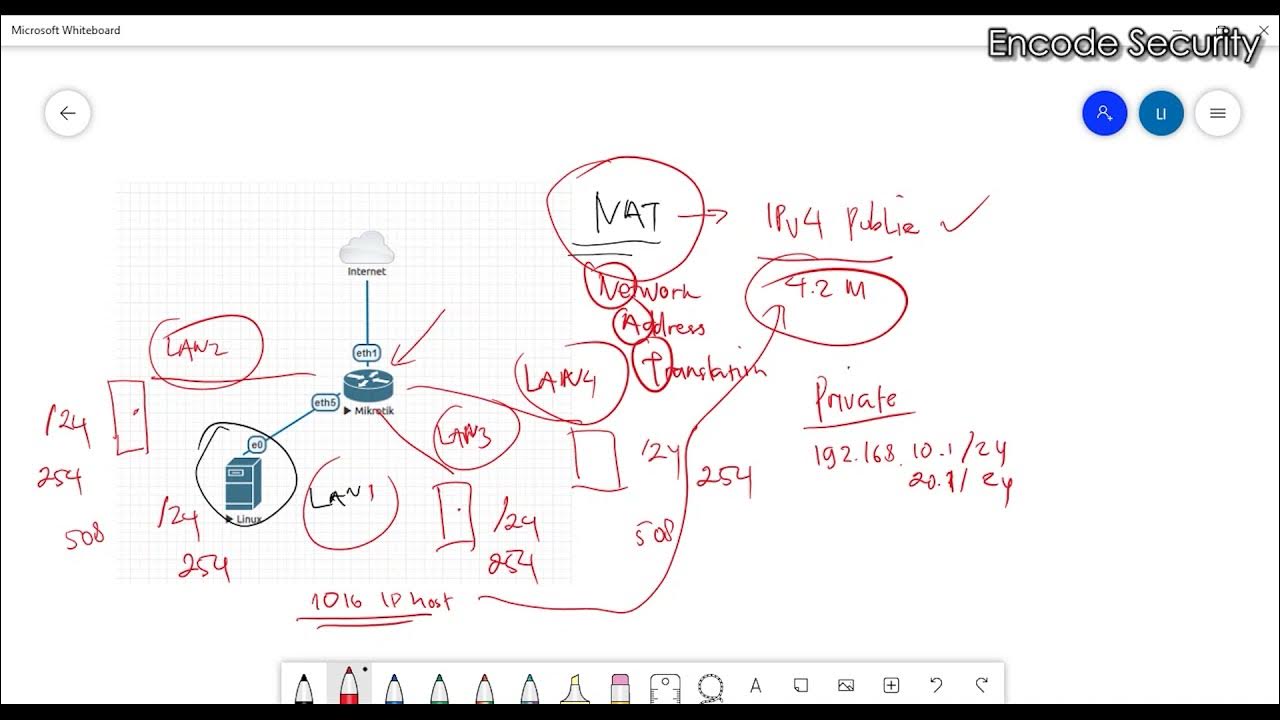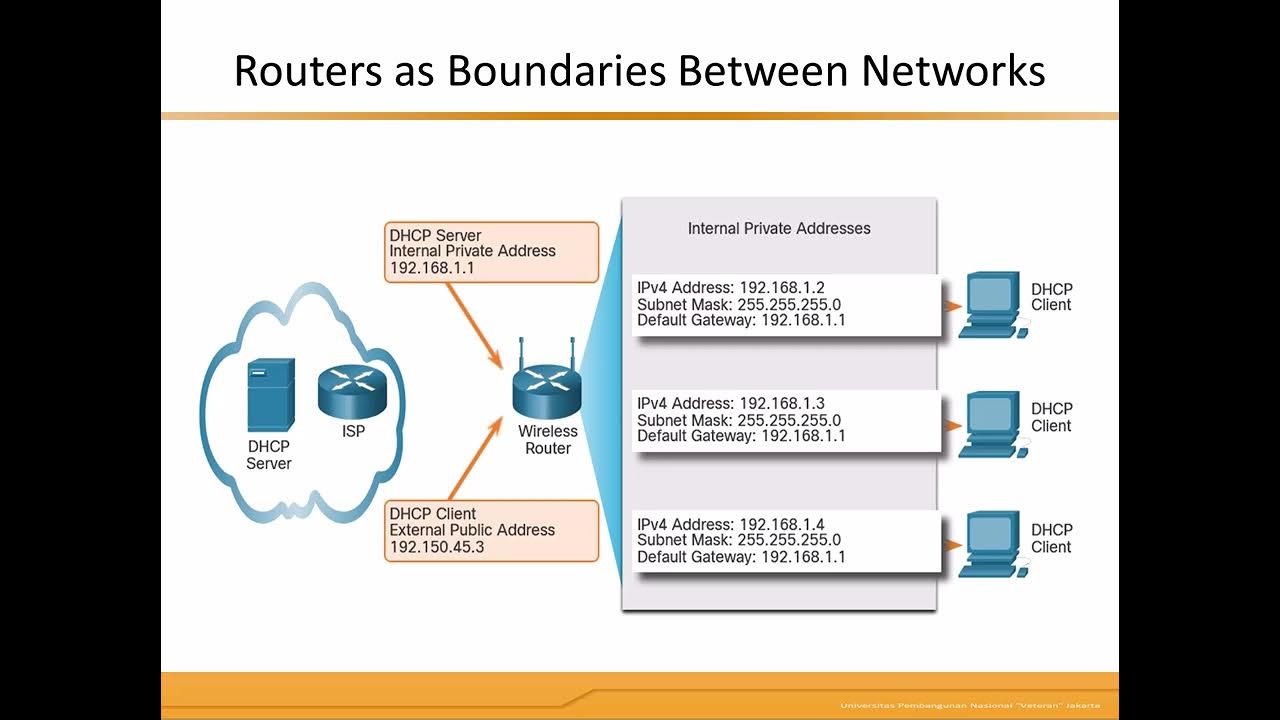NAT Explained - Network Address Translation
Summary
TLDRNetwork Address Translation (NAT) is a crucial service in routers that conserves the limited supply of IPv4 public addresses by translating private IP addresses for multiple devices to a single public IP. Created in response to the unforeseen growth of the internet, NAT allows for efficient internet access without the need for each device to have its own public IP address. As we transition to IPv6, which can provide a public IP for every device on Earth, the need for NAT and private IPs will diminish, thanks to its capability to generate over 340 undecillion unique addresses, ensuring no shortage in the future.
Takeaways
- 🌐 NAT stands for Network Address Translation, a service used in routers to manage IP addresses.
- 🔄 The purpose of NAT is to translate a set of IP addresses, typically from private to public, to conserve IP address space.
- 🚀 The creation of NAT was prompted by the realization that the initial 4 billion IPv4 addresses would not be sufficient for the growing internet.
- 📊 IPv4 addresses are divided into public and private types, with public addresses required for internet access and private addresses used internally.
- 🏢 Private IP addresses are not registered on the internet and cannot be used to directly access the internet; they are assigned by routers within a local network.
- 🔑 Routers assign private IP addresses to devices within a home or business, conserving the need for more public IP addresses from ISPs.
- 💡 NAT allows multiple devices with private IP addresses to share a single public IP address for internet access, reducing the demand for public IP addresses.
- 🔄 NAT not only translates private IP addresses to public but also vice versa, enabling communication between the internet and devices on a private network.
- 🌐 The future of IP addressing is IPv6, which can provide a public IP address for every device on earth, eliminating the need for NAT and private IP addresses.
- 🔢 IPv6 is capable of generating an astronomical number of IP addresses, specifically over 340 undecillion, ensuring that there will never be a shortage.
- 📈 With the advent of IPv6, the limitations of IPv4 and the need for NAT will be overcome, allowing for a more expansive and efficient internet infrastructure.
Q & A
What does NAT stand for and what is its primary function?
-NAT stands for Network Address Translation. Its primary function is to translate a set of IP addresses to another set, allowing for the conservation of the limited number of IPv4 public IP addresses available globally.
Why was NAT developed?
-NAT was developed to prevent a shortage of public IPv4 addresses. When the Internet expanded beyond the expectations of its creators, the initially available 4 billion IPv4 addresses were not sufficient, leading to the creation of private IP addresses and NAT.
What is the difference between public and private IPv4 addresses?
-Public IPv4 addresses are registered on the Internet and are necessary for devices to access the Internet. Private IPv4 addresses, on the other hand, are not publicly registered and cannot be used to directly access the Internet. They are used internally within a home or business network.
How many public IPv4 addresses are available, and why are they considered limited?
-There are approximately 4 billion public IPv4 addresses available, which are considered limited due to the vast number of devices requiring Internet access. This limitation necessitates the use of NAT to conserve these addresses.
Why is it impractical to assign a public IP address to every device that needs Internet access?
-Assigning a public IP address to every device would be expensive, unnecessary, and a waste of public IP addresses. It would also deplete the available public IPv4 addresses much faster, leading to a shortage.
How does a router assign IP addresses to devices within a home or business network?
-A router assigns private IP addresses to devices within a home or business network. When these devices need to access the Internet, their private IP addresses are translated by NAT to the public IP address provided by the Internet Service Provider.
What is the role of NAT when a device with a private IP address needs to access the Internet?
-NAT translates the private IP address of a device to a public IP address, allowing it to access the Internet. This process conserves the use of public IP addresses and allows multiple devices to share a single public IP address.
How does NAT facilitate communication between a computer on the Internet and a computer on a private network?
-NAT translates the public IP address of an incoming connection to the corresponding private IP address of the device on the private network, enabling communication between the two.
What is the significance of IP version 6 (IPv6) in relation to NAT and IP address conservation?
-IPv6 is a new generation of IP addresses that can produce over 340 undecillion addresses, eliminating the need for NAT and private IP addresses. With such a vast number of addresses, every device in the world can have its own public IP address.
Why will the adoption of IPv6 reduce the reliance on NAT?
-The adoption of IPv6 will reduce the reliance on NAT because IPv6 provides an almost inexhaustible supply of unique public IP addresses, making IP address translation unnecessary.
What is the estimated number of IP addresses that IPv6 can produce, and how does this compare to IPv4?
-IPv6 can produce over 340 undecillion IP addresses, which is a number with 36 digits after the 340. This is significantly larger than the 4 billion addresses available with IPv4, ensuring that there will never be a shortage of IP addresses.
Outlines

This section is available to paid users only. Please upgrade to access this part.
Upgrade NowMindmap

This section is available to paid users only. Please upgrade to access this part.
Upgrade NowKeywords

This section is available to paid users only. Please upgrade to access this part.
Upgrade NowHighlights

This section is available to paid users only. Please upgrade to access this part.
Upgrade NowTranscripts

This section is available to paid users only. Please upgrade to access this part.
Upgrade Now5.0 / 5 (0 votes)





